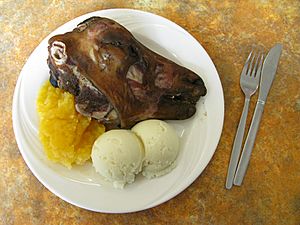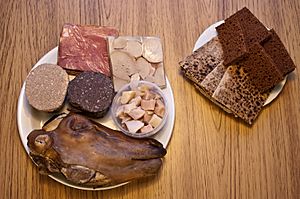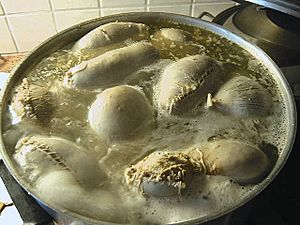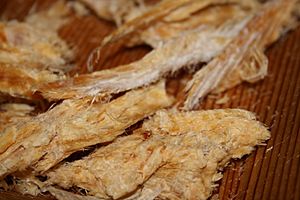Þorramatur facts for kids

Þorramatur (pronounced "THOR-ra-mah-tur") is a special selection of traditional Icelandic food. It mainly includes meat and fish dishes that are preserved in old ways. These foods are cut into slices or pieces and served with rúgbrauð (a dark, dense rye bread), butter, and brennivín (an Icelandic drink).
People eat Þorramatur during the Nordic month of Þorri, which is in January and February. It's especially popular at the mid-winter feast called Þorrablót. This feast celebrates old Icelandic culture. Because it's part of the Þorrablót festivals, Þorramatur is usually served as a buffet, where people can choose what they want to eat.
Contents
History of Þorramatur
How Þorramatur Began
Þorramatur is an example of a "new tradition" that started to feel old. It first appeared at mid-winter parties. These parties were for people who had moved from the countryside to Reykjavík after World War II. Many people moved to the city during this time.
These parties were very popular in the 1950s and 1960s. At these events, people would sometimes serve "Icelandic food" or "old Icelandic food." This was usually a buffet of country dishes. These foods were familiar to the people attending. However, they had become rare on the tables of city people by the mid-20th century.
The Restaurant Naustið and Its Idea
The idea to connect this type of buffet to the month of Þorri came from a restaurant in Reykjavík called Naustið. In 1958, this restaurant started advertising Þorramatur. This was the first time the word was used in Icelandic writings.
The food was served in large wooden troughs. These troughs were copies of old ones seen at the National Museum of Iceland. Each trough held enough food for four people. The restaurant owner wanted to give people who weren't part of a country association a chance to try traditional country food. It was also a way to get more customers during a quiet time of year for restaurants.
The idea was a big success! Naustið became very popular, and other restaurants quickly copied the idea. Soon, many student groups and regional associations that held yearly Þorrablót festivals started serving Þorramatur buffets at their events.
Changes Over Time
Þorramatur has changed a lot since the 1950s. The big mid-winter festivals in Reykjavík are now joined by many smaller ones. Today, even simple family get-togethers can be called Þorrablót. This means that eating Þorramatur is now a key part of any party called "Þorrablót."
At first, this led to the food becoming more standard. A few main foods were made in large amounts by big meat companies for the Þorrablót season. Before this, the food was usually bought locally. In the last 30 years, Þorrablót festivals have become very important in the countryside and villages across Iceland. As the tradition spread from the city back to the countryside, the buffet started to show regional foods and traditions again.
Þorramatur has also changed to fit modern tastes. The old way of storing meat in fermented whey gives it a strong sour taste. Many younger Icelanders today are not used to this taste. So, a Þorramatur buffet often offers both sour and non-sour versions of the same food. These are served on separate trays because the sour liquid can easily affect other foods.
Some new foods have also been added to the buffet. These are foods that have always been popular in Iceland. Examples include smoked lamb, fermented shark, and dried fish. These are still eaten all year round. Sometimes, Þorramatur might even include very rare traditional foods. These foods might have been known only in certain areas and even older people might not recognize them. An example is seal flippers, which were only known from the Breiðafjörður area. They are sometimes, but rarely, served as part of Þorramatur.
Popular Þorramatur Dishes
Þorramatur includes many different kinds of food:
- Kæstur hákarl: This is fermented Greenland shark. It has a very strong smell and taste.
- Súrsaðir hrútspungar: This is a special dish made from ram's meat. It is pressed into blocks, boiled, and preserved in lactic acid.
- Svið: These are sheep's heads that have been singed (burned to remove hair) and boiled. Sometimes they are also preserved in lactic acid.
- Sviðasulta: This is a type of head cheese made from svið. It can also be preserved in lactic acid.
- Lifrarpylsa (liver sausage): This is a pudding made from sheep's liver and fat. It's mixed with rye flour and oats.
- Blóðmör (blood-suet): This is a type of blood pudding. It's made from lamb's blood and fat, mixed with rye flour and oats.
- Harðfiskur: This is fish (like cod or haddock) that has been dried by the wind. It's usually eaten with butter.
- Rúgbrauð (rye bread): This is traditional Icelandic rye bread, often dark and dense.
- Hangikjöt: This means "hung meat." It's smoked and boiled lamb or mutton. Sometimes it's also eaten raw.
- Lundabaggi: This dish uses sheep's loins wrapped in meat from the sides. It's pressed and preserved in lactic acid.
- Selshreifar: These are seal's flippers preserved in lactic acid.
- Súr Hvalur: This is whale meat pickled in sour milk.
- Rófustappa: This is mashed turnips.
During the month of Þorri, Þorramatur buffets are very popular in Iceland. Many restaurants in Reykjavík and other places serve Þorramatur. It's often served on wooden platters called trog (trough). At these gatherings, people often drink a lot of Icelandic Brennivín. You can also find plastic trays with a selection of Þorramatur foods in supermarkets during mid-winter.
See also
 In Spanish: Þorramatur para niños
In Spanish: Þorramatur para niños




